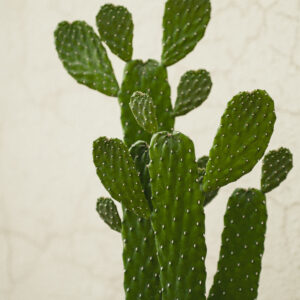Cactus Opuntia, commonly known as prickly pear cactus, is a genus of cacti in the family Cactaceae. It is native to the Americas and is widely distributed across North, Central, and South America. Prickly pear cacti are well-known for their unique appearance, with flattened, pad-like stems covered in spines, and their colorful and edible fruits called tunas or prickly pears.
Care of cactus opuntia:
Light: Prickly pear cacti thrive in full sunlight. They require at least 6 to 8 hours of direct sunlight daily to grow and flower properly.
Temperature: Opuntia cacti are well-adapted to warm and arid climates. They can tolerate high temperatures and are often found in desert regions.
Watering: Prickly pear cacti are drought-tolerant and can store water in their pads. They should be watered sparingly, allowing the soil to dry out between waterings to prevent root rot.
Soil: These cacti prefer well-draining soil, such as sandy or rocky soil, to prevent waterlogged conditions.
Fertilization: Opuntia cacti do not require frequent fertilization. A low-nitrogen fertilizer applied sparingly during the growing season can be beneficial.
Characteristics of cactus opuntia:
Stems: Prickly pear cacti have flattened, succulent stems that are modified into pads or cladodes. These pads can vary in shape, size, and color, depending on the species and environmental conditions. The pads contain chlorophyll, which allows the cactus to perform photosynthesis.
Spines: Opuntia cacti are covered in spines or glochids, which are tiny hair-like structures that are actually modified spines. Spines and glochids serve as a defense mechanism against herbivores and can cause irritation if touched.
Flowers: Prickly pear cacti produce striking and colorful flowers. The flowers can be yellow, orange, pink, or red, and they often bloom in the warmer months of the year. The flowers are typically large and showy, attracting pollinators such as bees, butterflies, and birds.
Fruits: After the flowers are pollinated, they develop into fleshy and edible fruits called tunas or prickly pears. The fruits are sweet and juicy, and they come in various colors, including green, yellow, orange, and red. They are a popular ingredient in various culinary dishes and beverages.
Landscape Use of cactus Opuntia:
Prickly pear cacti are commonly grown in gardens, landscapes, and xeriscapes in arid and dry regions.
They can be used as ornamental plants, providing a unique and architectural element to outdoor spaces.
Some species of Opuntia are also grown for their edible fruits, which are used in culinary preparations and traditional medicine in various cultures.
Overall, Opuntia (prickly pear cactus) is a fascinating and versatile group of cacti, appreciated for their striking appearance, colorful flowers, and edible fruits. They are a favorite choice for water-wise gardening and are ideal for those seeking low-maintenance and drought-tolerant plants in arid climates.








